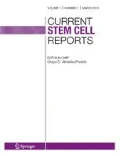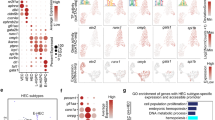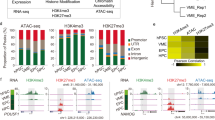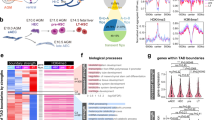Abstract
Purpose of the Review
Blood specification is a highly dynamic process, whereby committed hemogenic endothelial cells (ECs) progressively transdifferentiate into multipotent, self-renewing hematopoietic stem cells (HSCs). Massive changes in gene expression must occur to switch cell identity; however, the factors that mediate such an effect were a mystery until recently. This review summarizes the higher-order mechanisms involved in endothelial to hematopoietic reprogramming identified thus far.
Recent Findings
Accumulating evidence from mouse and zebrafish studies reveal that numerous chromatin-modifying (epigenetic) and RNA-modifying (epitranscriptomic) factors are required for the formation of HSCs from hemogenic endothelium. These genes function throughout the endothelial-hematopoietic transition, suggesting a dynamic interplay between “epi”-machineries.
Summary
Epigenetic and epitranscriptomic regulation are key mechanisms for reshaping global EC gene expression patterns to those that support HSC production. Future studies that capture modification dynamics should bring us closer to a complete understanding of how HSCs transition from hemogenic endothelium at the molecular level.

Similar content being viewed by others
References
Papers of particular interest, published recently, have been highlighted as: • Of importance •• Of major importance
Medvinsky A, Dzierzak E. Definitive hematopoiesis is autonomously initiated by the AGM region. Cell. 1996;86(6):897–906. https://doi.org/10.1016/S0092-8674(00)80165-8.
Jaffredo T, Gautier R, Eichmann A, Dieterlen-Lievre F. Intraaortic hemopoietic cells are derived from endothelial cells during ontogeny. Development. 1998;125(22):4575–83.
Zovein AC, Hofmann JJ, Lynch M, French WJ, Turlo KA, Yang Y, et al. Fate tracing reveals the endothelial origin of hematopoietic stem cells. Cell Stem Cell. 2008;3(6):625–36. https://doi.org/10.1016/j.stem.2008.09.018.
Bertrand JY, Chi NC, Santoso B, Teng S, Stainier DY, Traver D. Haematopoietic stem cells derive directly from aortic endothelium during development. Nature. 2010;464(7285):108–11. https://doi.org/10.1038/nature08738.
Boisset JC, van Cappellen W, Andrieu-Soler C, Galjart N, Dzierzak E, Robin C. In vivo imaging of haematopoietic cells emerging from the mouse aortic endothelium. Nature. 2010;464(7285):116–20. https://doi.org/10.1038/nature08764.
Kissa K, Herbomel P. Blood stem cells emerge from aortic endothelium by a novel type of cell transition. Nature. 2010;464(7285):112–5. https://doi.org/10.1038/nature08761.
Ge L, Zhang RP, Wan F, Guo DY, Wang P, Xiang LX, et al. TET2 plays an essential role in erythropoiesis by regulating lineage-specific genes via DNA oxidative demethylation in a zebrafish model. Mol Cell Biol. 2014;34(6):989–1002. https://doi.org/10.1128/MCB.01061-13.
• Li C, Lan Y, Schwartz-Orbach L, Korol E, Tahiliani M, Evans T, et al. Overlapping requirements for Tet2 and Tet3 in normal development and hematopoietic stem cell emergence. Cell Rep. 2015;12(7):1133–43. https://doi.org/10.1016/j.celrep.2015.07.025. Generated a Tet family mutant allelic series to reveal an overlapping requirement for Tet2 and Tet3 in HSC formation, upstream of VDA Notch signaling.
• Liu X, Jia X, Yuan H, Ma K, Chen Y, Jin Y, et al. DNA methyltransferase 1 functions through C/ebpa to maintain hematopoietic stem and progenitor cells in zebrafish. J Hematol Oncol. 2015;8(1):15. https://doi.org/10.1186/s13045-015-0115-7. Demonstrated that decreased promoter methylation of the cell cycle inhibitor C/ebpa was responsible for the HSC proliferation defect in dnmt1 mutants.
•• Gore AV, Athans B, Iben JR, Johnson K, Russanova V, Castranova D, et al. Epigenetic regulation of hematopoiesis by DNA methylation. elife. 2016;5:e11813. https://doi.org/10.7554/eLife.11813. Assessed genome-wide DNA methylome and transcriptome patterns of dnmt3bb.1 morphants, and revealed that the cmyb gene body is the primary target of Dnmt3bb.1. Ectopic dnmt3bb.1 expression was sufficient to drive cmyb expression in non-endothelial cells.
• Eliades A, Wareing S, Marinopoulou E, Fadlullah MZH, Patel R, Grabarek JB, et al. The hemogenic competence of endothelial progenitors is restricted by Runx1 silencing during embryonic development. Cell Rep. 2016;15(10):2185–99. https://doi.org/10.1016/j.celrep.2016.05.001. Revealed PRC1 member BMI acts during hemogenic EC specification to maintain EC identity by repressing Runx1. Ectopic BMI can restore hemogenic potential to incompetent EC progenitors.
Yu M, Mazor T, Huang H, Huang HT, Kathrein KL, Woo AJ, et al. Direct recruitment of polycomb repressive complex 1 to chromatin by core binding transcription factors. Mol Cell. 2012;45(3):330–43. https://doi.org/10.1016/j.molcel.2011.11.032.
Huang HT, Kathrein KL, Barton A, Gitlin Z, Huang YH, Ward TP, et al. A network of epigenetic regulators guides developmental haematopoiesis in vivo. Nat Cell Biol. 2013;15(12):1516–25. https://doi.org/10.1038/ncb2870.
•• Thambyrajah R, Mazan M, Patel R, Moignard V, Stefanska M, Marinopoulou E, et al. GFI1 proteins orchestrate the emergence of haematopoietic stem cells through recruitment of LSD1. Nat Cell Biol. 2016;18(1):21–32. https://doi.org/10.1038/ncb3276. AGM explants deficient for either LSD1 or Gfi1/1b arrest in EHT and fail to emerge from the VDA. Many genes bound by GFI1/1b are upregulated by LSD inhibition in hemogenic ECs, suggesting that these proteins cooperate to repress EC gene expression, thereby promoting HSC maturation.
Burns CE, Galloway JL, Smith AC, Keefe MD, Cashman TJ, Paik EJ, et al. A genetic screen in zebrafish defines a hierarchical network of pathways required for hematopoietic stem cell emergence. Blood. 2009;113(23):5776–82. https://doi.org/10.1182/blood-2008-12-193607.
• Koh FM, Lizama CO, Wong P, Hawkins JS, Zovein AC, Ramalho-Santos M. Emergence of hematopoietic stem and progenitor cells involves a Chd1-dependent increase in total nascent transcription. Proc Natl Acad Sci U S A. 2015;112(14):E1734–43. https://doi.org/10.1073/pnas.1424850112. Chd1 was the first chromatin remodeling ATPase identified to regulate HSC formation from hemogenic endothelium in mouse. Chd1 increases global transcriptional output at pro-hematopoietic genes.
• Yang Q, Liu X, Zhou T, Cook J, Nguyen K, Bai X. RNA polymerase II pausing modulates hematopoietic stem cell emergence in zebrafish. Blood. 2016;128(13):1701–10. https://doi.org/10.1182/blood-2016-02-697847. Performed MNAse protection assays to show that Pol II pausing promotes transcription of several pro-HSC genes by preventing nucleosome assembly.
• Majumder A, Syed KM, Joseph S, Scambler PJ, Dutta D. Histone chaperone HIRA in regulation of transcription factor RUNX1. J Biol Chem. 2015;290(21):13053–63. https://doi.org/10.1074/jbc.M114.615492. Demonstrated that HIRA chaperone incorporates histone H3.3 variant at the Runx1 locus to promote its expression in ESC-derived hemogenic ECs.
•• Zhang C, Chen Y, Sun B, Wang L, Yang Y, Ma D, et al. m6A modulates haematopoietic stem and progenitor cell specification. Nature. 2017;549(7671):273–6. https://doi.org/10.1038/nature23883. First to show that epitranscriptomic marks regulate EHT in zebrafish and mouse. m6A methylation of notch1a by Mettl3 promotes its Ythdf2-mediated decay, leading to HSC production.
Swiers G, Baumann C, O'Rourke J, Giannoulatou E, Taylor S, Joshi A, et al. Early dynamic fate changes in haemogenic endothelium characterized at the single-cell level. Nat Commun. 2013;4:2924. https://doi.org/10.1038/ncomms3924.
Solaimani Kartalaei P, Yamada-Inagawa T, Vink CS, de Pater E, van der Linden R, Marks-Bluth J, et al. Whole-transcriptome analysis of endothelial to hematopoietic stem cell transition reveals a requirement for Gpr56 in HSC generation. J Exp Med. 2015;212(1):93–106. https://doi.org/10.1084/jem.20140767.
Guibentif C, Ronn RE, Boiers C, Lang S, Saxena S, Soneji S, et al. Single-cell analysis identifies distinct stages of human endothelial-to-hematopoietic transition. Cell Rep. 2017;19(1):10–9. https://doi.org/10.1016/j.celrep.2017.03.023.
Rowe RG, Mandelbaum J, Zon LI, Daley GQ. Engineering hematopoietic stem cells: lessons from development. Cell Stem Cell. 2016;18(6):707–20. https://doi.org/10.1016/j.stem.2016.05.016.
Gritz E, Hirschi KK. Specification and function of hemogenic endothelium during embryogenesis. Cell Mol Life Sci. 2016;73(8):1547–67. https://doi.org/10.1007/s00018-016-2134-0.
Butko E, Pouget C, Traver D. Complex regulation of HSC emergence by the notch signaling pathway. Dev Biol. 2016;409(1):129–38. https://doi.org/10.1016/j.ydbio.2015.11.008.
Yzaguirre AD, de Bruijn MF, Speck NA. The role of Runx1 in embryonic blood cell formation. Adv Exp Med Biol. 2017;962:47–64. https://doi.org/10.1007/978-981-10-3233-2_4.
Frame JM, Lim SE, North TE. Hematopoietic stem cell development: using the zebrafish to identify extrinsic and intrinsic mechanisms regulating hematopoiesis. Methods Cell Biol. 2017;138:165–92. https://doi.org/10.1016/bs.mcb.2016.08.004.
Li C, Evans T, Goll MG. Epigenetic regulation of hematopoietic stem cell development. Methods Cell Biol. 2016;135:431–48. https://doi.org/10.1016/bs.mcb.2016.01.010.
Atlasi Y, Stunnenberg HG. The interplay of epigenetic marks during stem cell differentiation and development. Nat Rev Genet. 2017;18(11):643–58. https://doi.org/10.1038/nrg.2017.57.
Cullen SM, Mayle A, Rossi L, Goodell MA. Hematopoietic stem cell development: an epigenetic journey. Curr Top Dev Biol. 2014;107:39–75. https://doi.org/10.1016/B978-0-12-416022-4.00002-0.
Edwards JR, Yarychkivska O, Boulard M, Bestor TH. DNA methylation and DNA methyltransferases. Epigenetics Chromatin. 2017;10(1):23. https://doi.org/10.1186/s13072-017-0130-8.
Baubec T, Colombo DF, Wirbelauer C, Schmidt J, Burger L, Krebs AR, et al. Genomic profiling of DNA methyltransferases reveals a role for DNMT3B in genic methylation. Nature. 2015;520(7546):243–7. https://doi.org/10.1038/nature14176.
Yang X, Han H, De Carvalho DD, Lay FD, Jones PA, Liang G. Gene body methylation can alter gene expression and is a therapeutic target in cancer. Cancer Cell. 2014;26(4):577–90. https://doi.org/10.1016/j.ccr.2014.07.028.
Rasmussen KD, Helin K. Role of TET enzymes in DNA methylation, development, and cancer. Genes Dev. 2016;30(7):733–50. https://doi.org/10.1101/gad.276568.115.
Avellino R, Delwel R. Expression and regulation of C/EBPalpha in normal myelopoiesis and in malignant transformation. Blood. 2017;129(15):2083–91. https://doi.org/10.1182/blood-2016-09-687822.
Li E, Bestor TH, Jaenisch R. Targeted mutation of the DNA methyltransferase gene results in embryonic lethality. Cell. 1992;69(6):915–26. https://doi.org/10.1016/0092-8674(92)90611-F.
Watanabe D, Suetake I, Tajima S, Hanaoka K. Expression of Dnmt3b in mouse hematopoietic progenitor cells and spermatogonia at specific stages. Gene Expr Patterns. 2004;5(1):43–9. https://doi.org/10.1016/j.modgep.2004.06.008.
Chen MJ, Yokomizo T, Zeigler BM, Dzierzak E, Speck NA. Runx1 is required for the endothelial to haematopoietic cell transition but not thereafter. Nature. 2009;457(7231):887–91. https://doi.org/10.1038/nature07619.
Saleque S, Kim J, Rooke HM, Orkin SH. Epigenetic regulation of hematopoietic differentiation by Gfi-1 and Gfi-1b is mediated by the cofactors CoREST and LSD1. Mol Cell. 2007;27(4):562–72. https://doi.org/10.1016/j.molcel.2007.06.039.
Lancrin C, Mazan M, Stefanska M, Patel R, Lichtinger M, Costa G, et al. GFI1 and GFI1B control the loss of endothelial identity of hemogenic endothelium during hematopoietic commitment. Blood. 2012;120(2):314–22. https://doi.org/10.1182/blood-2011-10-386094.
Wissmann M, Yin N, Muller JM, Greschik H, Fodor BD, Jenuwein T, et al. Cooperative demethylation by JMJD2C and LSD1 promotes androgen receptor-dependent gene expression. Nat Cell Biol. 2007;9(3):347–53. https://doi.org/10.1038/ncb1546.
Arulmozhivarman G, Krater M, Wobus M, Friedrichs J, Bejestani EP, Muller K, et al. Zebrafish in-vivo screening for compounds amplifying hematopoietic stem and progenitor cells:—preclinical validation in human CD34+ stem and progenitor cells. Sci Rep. 2017;7(1):12084. https://doi.org/10.1038/s41598-017-12360-0.
Hota SK, Bruneau BG. ATP-dependent chromatin remodeling during mammalian development. Development. 2016;143(16):2882–97. https://doi.org/10.1242/dev.128892.
Burgess RJ, Zhang Z. Histone chaperones in nucleosome assembly and human disease. Nat Struct Mol Biol. 2013;20(1):14–22. https://doi.org/10.1038/nsmb.2461.
Skene PJ, Hernandez AE, Groudine M, Henikoff S. The nucleosomal barrier to promoter escape by RNA polymerase II is overcome by the chromatin remodeler Chd1. elife. 2014;3:e02042. https://doi.org/10.7554/eLife.02042.
Gaertner B, Zeitlinger J. RNA polymerase II pausing during development. Development. 2014;141(6):1179–83. https://doi.org/10.1242/dev.088492.
Saletore Y, Meyer K, Korlach J, Vilfan ID, Jaffrey S, Mason CE. The birth of the Epitranscriptome: deciphering the function of RNA modifications. Genome Biol. 2012;13(10):175. https://doi.org/10.1186/gb-2012-13-10-175.
Liu N, Pan T. N6-methyladenosine-encoded epitranscriptomics. Nat Struct Mol Biol. 2016;23(2):98–102. https://doi.org/10.1038/nsmb.3162.
Meyer KD, Jaffrey SR. Rethinking m6A readers, writers, and erasers. Annu Rev Cell Dev Biol. 2017;33(1):319–42. https://doi.org/10.1146/annurev-cellbio-100616-060758.
Wang X, Zhao BS, Roundtree IA, Lu Z, Han D, Ma H, et al. N(6)-methyladenosine modulates messenger RNA translation efficiency. Cell. 2015;161(6):1388–99. https://doi.org/10.1016/j.cell.2015.05.014.
Wang X, Lu Z, Gomez A, Hon GC, Yue Y, Han D, et al. N6-methyladenosine-dependent regulation of messenger RNA stability. Nature. 2014;505(7481):117–20. https://doi.org/10.1038/nature12730.
Zheng G, Dahl JA, Niu Y, Fedorcsak P, Huang CM, Li CJ, et al. ALKBH5 is a mammalian RNA demethylase that impacts RNA metabolism and mouse fertility. Mol Cell. 2013;49(1):18–29. https://doi.org/10.1016/j.molcel.2012.10.015.
Mauer J, Luo X, Blanjoie A, Jiao X, Grozhik AV, Patil DP, et al. Reversible methylation of m(6)Am in the 5′ cap controls mRNA stability. Nature. 2017;541(7637):371–5. https://doi.org/10.1038/nature21022.
Lichtinger M, Ingram R, Hannah R, Muller D, Clarke D, Assi SA, et al. RUNX1 reshapes the epigenetic landscape at the onset of haematopoiesis. EMBO J. 2012;31(22):4318–33. https://doi.org/10.1038/emboj.2012.275.
Alvarez-Dominguez JR, Lodish HF. Emerging mechanisms of long noncoding RNA function during normal and malignant hematopoiesis. Blood. 2017;130(18):1965–75. https://doi.org/10.1182/blood-2017-06-788695.
Jeong M, Goodell MA. Noncoding regulatory RNAs in hematopoiesis. Curr Top Dev Biol. 2016;118:245–70. https://doi.org/10.1016/bs.ctdb.2016.01.006.
Jonas S, Izaurralde E. Towards a molecular understanding of microRNA-mediated gene silencing. Nat Rev Genet. 2015;16(7):421–33. https://doi.org/10.1038/nrg3965.
Zardo G, Ciolfi A, Vian L, Starnes LM, Billi M, Racanicchi S, et al. Polycombs and microRNA-223 regulate human granulopoiesis by transcriptional control of target gene expression. Blood. 2012;119(17):4034–46. https://doi.org/10.1182/blood-2011-08-371344.
Kasper DM, Moro A, Ristori E, Narayanan A, Hill-Teran G, Fleming E, et al. MicroRNAs establish uniform traits during the architecture of vertebrate embryos. Dev Cell. 2017;40(6):552–65 e5. https://doi.org/10.1016/j.devcel.2017.02.021.
Chen T, Hao YJ, Zhang Y, Li MM, Wang M, Han W, et al. m(6)A RNA methylation is regulated by microRNAs and promotes reprogramming to pluripotency. Cell Stem Cell. 2015;16(3):289–301. https://doi.org/10.1016/j.stem.2015.01.016.
Lu X, Li X, He Q, Gao J, Gao Y, Liu B, et al. miR-142-3p regulates the formation and differentiation of hematopoietic stem cells in vertebrates. Cell Res. 2013;23(12):1356–68. https://doi.org/10.1038/cr.2013.145.
Jiang X, Hawkins JS, Lee J, Lizama CO, Bos FL, Zape JP, et al. Let-7 microRNA-dependent control of leukotriene signaling regulates the transition of hematopoietic niche in mice. Nat Commun. 2017;8(1):128. https://doi.org/10.1038/s41467-017-00137-y.
Nimmo R, Ciau-Uitz A, Ruiz-Herguido C, Soneji S, Bigas A, Patient R, et al. MiR-142-3p controls the specification of definitive hemangioblasts during ontogeny. Dev Cell. 2013;26(3):237–49. https://doi.org/10.1016/j.devcel.2013.06.023.
Patil DP, Chen CK, Pickering BF, Chow A, Jackson C, Guttman M, et al. m(6)A RNA methylation promotes XIST-mediated transcriptional repression. Nature. 2016;537(7620):369–73. https://doi.org/10.1038/nature19342.
Acknowledgments
We apologize to those whose original work could not be cited due to space limitations. D.M.K. is supported by NHLBI F32HL132475 and NIDDK U54DK106857.
Author information
Authors and Affiliations
Corresponding author
Ethics declarations
Conflict of Interest
Dionna M. Kasper and Stefania Nicoli declare that they have no conflict of interest.
Human and Animal Rights and Informed Consent
This article does not contain any studies with human or animal subjects performed by any of the authors.
Additional information
This article is part of the Topical Collection on Stem Cell Switches and Regulators
Rights and permissions
About this article
Cite this article
Kasper, D.M., Nicoli, S. Epigenetic and Epitranscriptomic Factors Make a Mark on Hematopoietic Stem Cell Development. Curr Stem Cell Rep 4, 22–32 (2018). https://doi.org/10.1007/s40778-018-0113-0
Published:
Issue Date:
DOI: https://doi.org/10.1007/s40778-018-0113-0




